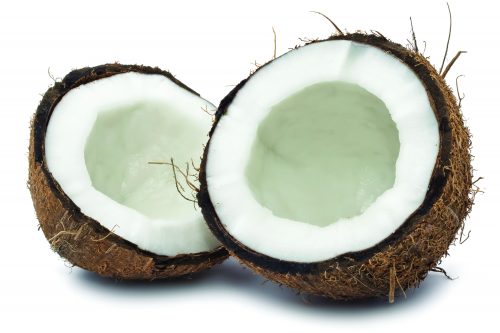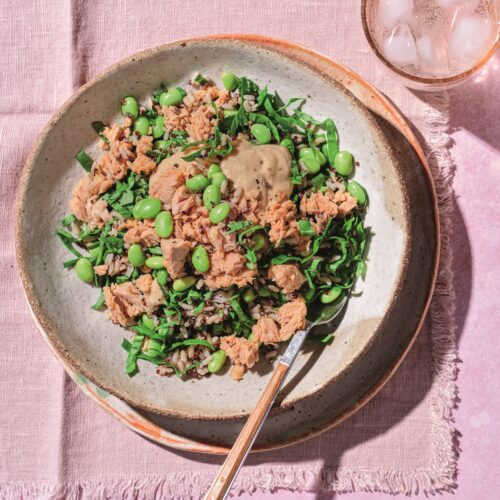
HFG senior nutritionist Rose Carr investigates the nutritional value and differences between coconut products.
When a coconut is opened it contains coconut water and white flesh. The water is an almost clear juice, and the flesh can be referred to as the meat. Coconut milk and coconut cream are made from the flesh of the coconut.
To extract the milk and cream, coconut flesh is ground to a fine pulp and the juice separated from the pulp, often by pressing. Water is commonly added to the pulp prior to pressing. When left to settle, the fluid separates into a higher-fat cream and a lower-fat milk. Reduced-fat products have a higher water content. Coconut cream and coconut milk may be homogenised: the fat globules are broken up into smaller particles so they disperse evenly. The texture is smoother and the cream does not separate in homogenised milk/cream. Stabilisers and thickeners are sometimes added.
Fat and energy
The main nutrient in coconut milk and coconut cream is fat which means it can pack a punch in terms of kilojoules. Coconut cream can contain between 800-1200kJ in just 100ml and coconut milk 750-1000kJ per 100ml. The amount of fat varies widely between different brands, from 14-29 per cent, excluding reduced-fat varieties, so it can be a trap if you don’t check the nutrition information panels.
Some reduced-fat products can be as high in fat as another brand’s regular variety due to variations in the water content. Reduced-fat varieties of coconut milk and coconut cream ranged from seven to 17 per cent fat. It’s also worth noting that some brands of coconut cream have less fat than another brand’s coconut milk.
A very high proportion of the fat in coconut milk and coconut cream is saturated fat: in the products we surveyed saturated fat accounted for between 60-93 per cent of the total fat. Current dietary recommendations advise us to limit our intake of saturated fats to reduce the risk of cardiovascular disease.
In the nutritional science community, however, whether or not the saturated fats in coconut products are really bad for us is quite a hot topic. This is because different saturated fats have different levels of effect on cholesterol in our bodies. Coconut oil, the fat found in coconut milk and coconut cream, is very high in lauric acid. This is a saturated fat which seems to not only increase LDL (‘bad’) cholesterol but also HDL (‘good’) cholesterol. This means the ratio of total cholesterol to HDL cholesterol, thought to be the most important measure for heart health, may not be altered by lauric acid.
While scientists continue their debate on specific saturated fats, we might be better to err on the side of caution. And we do know that carrying excess fat, especially around our middle, is not good for our health. So while coconut milk or coconut cream can be an enjoyable part of our diet, it is probably a good idea to practise moderation.
Alternatives
If you need that coconut flavour but don’t have coconut milk in the pantry, reduced-fat coconut- flavoured evaporated milk is a great alternative. It has fewer kilojoules than most coconut milks on the market, (the exception being Trident light coconut milk), as it is very low in fat. The kilojoules in reduced-fat evaporated milk are from the sugars, mainly lactose, the natural sugar in milk. Plain reduced-fat evaporated milk with a few drops of coconut essence added will also provide a simple alternative to coconut milk.
Portion control
One of our favourite products is Trident Light Coconut Milk in the 165ml can. Not only is this the lowest energy and lowest fat of the coconut milk and coconut cream products we found, the small portion size makes it hard to overdo it. It’s ideal if you’re preparing a meal for two to three people and could be stretched to four serves. Often it’s the flavour we want rather than extra liquid. For six serves, you will probably need the 400ml can.
HFG picks
Trident light coconut milk — 165ml can and 400ml can
7g fat (6.5g saturated), 3.8g sugars, 358kJ per 100ml
Trident light coconut cream — 165ml can and 400ml can
8.7g fat (8.1g saturated),0.2g sugars, 363kJ per 100ml
Carnation light and creamy coconut flavoured evaporated milk — 375ml can
1.6g fat (1.1g saturated), 12.6g sugars, 415kJ per 100ml
Tips
- Unless adding energy (kJ) is your goal, we recommend choosing coconut milk rather than the higher-fat coconut cream and selecting a reduced-fat version.
- If your canned coconut milk is higher in fat and kilojoules than what is ideal, don’t be afraid to make your own reduced-fat version: add water and stir well.
- You don’t have to use the whole can at once. Leftover coconut milk can be placed in a sealed container and refrigerated for a few days or frozen. Once thawed it will have separated and the texture will be a bit grainy, so it’s not suitable for all dishes.
- Coconut-flavoured evaporated milk can be used in place of coconut milk or cream in recipes. Take care not to overheat it, though, as it can split when boiled.
www.healthyfood.com










